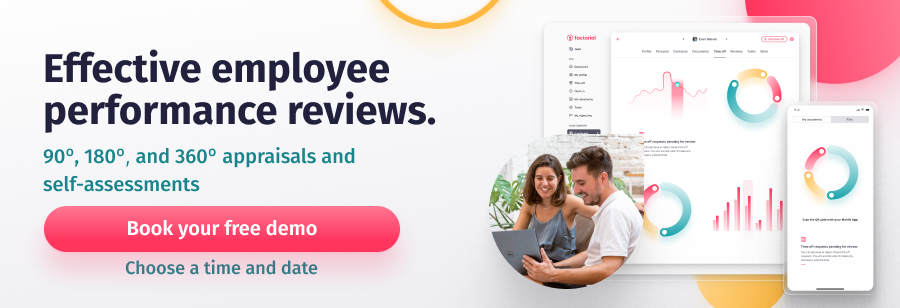It’s become a priority for companies to adopt a solid L&D strategy to promote employee growth and develop a highly skilled workforce. HR teams are investing in their employees to help them gain more technical, social, and emotional skills.
But what is the purpose of training and development? Why it’s so important to companies today, and how do you implement effective programmes to nurture your workforce and improve performance? We’ll cover all of this below.
What is Employee Training and Development?
Training and development programs are educational activities organised by an employer for the benefit of their employee. They are processes and activities designed to enhance the knowledge, skills, and abilities of individuals within an organisation. These efforts are aimed at improving an individual’s or a group’s performance, productivity, and effectiveness in their current or future roles.
HR teams use training and development programmes to support their workforce in acquiring industry knowledge and expertise required to grow professionally. Companies who invest in these L&D methods understand that it’s more profitable to invest in developing the skills of their existing workforce than sourcing new talent.
Benefits of Employee Training and Development in the Workplace
There are numerous reasons why you might want to adopt a training and development strategy. Here are a few of the key advantages:
- Skill gaps: Companies are facing growing skills gaps which have emerged due to emerging technologies and working models that have shifted the demand for skills. Re-skilling initiatives can help you retrain your existing employees, enabling you to meet your long-term organisational goals and keep up with an evolving industry.
- Growth opportunities: By promoting employee development, you will be showing current and future employees that you care about their professional progression and career development. This can help you attract and retain the right top talent to take your business to the next level.
- Retention and engagement: Employees with access to training and development initiatives are likely to feel more motivated and satisfied within their company. In fact, 76% of employees are more likely to stay with a company that offers continuous training.
- Creativity, productivity, and morale: The more confidence a workforce has in its skills and abilities, the more productive, creative, and innovative it will be. Providing employee training and nurturing new skills also boosts morale as your employees feel more valued and heard.

Types of Employee Training
A training plan might be made up of various types of development programs, such as the following:
- Onboarding: Facilitates the smooth integration of new employees, covering company culture, policies, and job expectations to help them become productive team members quickly.
- Safety Training: Focuses on educating employees about workplace safety measures, procedures, and protocols to prevent accidents and ensure a secure working environment.
- Skills Training: Enhances specific job-related abilities, ensuring employees acquire and improve the skills necessary for their roles.
- Technical Training: Provides instruction on using specific tools, technologies, or software, ensuring employees are proficient in technical aspects relevant to their roles.
- Customer Service Training: Equips employees with communication and problem-solving skills to deliver exceptional customer experiences and handle various customer interactions effectively.
- Leadership Skills: Develops qualities such as decision-making, communication, emotional intelligence and strategic thinking to prepare individuals for leadership roles within the organisation.
- Continuous Training: Involves ongoing learning initiatives to keep employees updated on industry trends, new technologies, and evolving skills, ensuring they remain competent and adaptable in their roles.
Effective Employee Training Methods
There are many types of employee training and development methods to choose from, including:
- Instructor-led training: This can take place either in-person or virtual (also called ‘e-learning’). There may be one or more instructors, who are responsible for teaching skills or sharing knowledge with an employee or group of employees. This may be done through lectures, presentations, demonstrations, and discussions.
- On-the-job training (OTJ): requires workers to learn the job in the actual work environment. This method of training is based on the principle of “learning by doing”, enabling employees to learn new skills while in the flow of work.
- Coaching or Mentoring: These are both collaborative processes that help to enhance the performance of the individual, team, and organisation as a whole. Coaching is an interactive process that involves all levels of the business. Mentors often act as role models for their mentees and provide guidance to help them reach their goals and progress professionally.
- Blended Learning: This refers to a training program that includes a variety of the training types referenced above. The blended learning approach often includes a combination of in-person training and online learning.

- Feedback-Oriented Training: This training approach places a strong emphasis on providing feedback to individuals during and after the learning process. The feedback is designed to be constructive, specific, and actionable, helping learners understand their strengths, weaknesses, and areas for improvement.
- Sharing Employee Success Stories: Using case studies for educational purposes fosters inspiration, motivation, and a positive culture. These stories serve as real-life examples, offering valuable insights into overcoming challenges and showcasing the soft skills that contribute to success.
- Gamification: This training method involves applying game elements, such as points, badges, and competition, to non-game contexts. It enhances engagement, motivation, and knowledge retention by making learning interactive and enjoyable. Learners are motivated to achieve goals and progress, fostering a more dynamic and effective learning experience.
How to Build Training Programs in 4 Steps
Creating a development/employee training program takes a lot of planning. After all, you need to consider all of the relevant skills and learning objectives specific to each role. Here are the 4 crucial steps you need to follow:
- Assessment and Planning: Begin with a thorough needs assessment to identify gaps in skills or knowledge. Understand organisational goals and align training objectives. Develop a detailed plan outlining goals, target audience, content, and desired outcomes.
- Design and Development: Based on the plan, design engaging and relevant training materials. Consider diverse learning styles and use various formats, including workshops, e-learning modules, and hands-on activities. Incorporate interactive elements to enhance engagement and knowledge retention.
- Implementation: Execute the training program systematically. Communicate clearly with participants about the program’s purpose, schedule, and expectations. Utilise a mix of training methods and provide ample opportunities for practice and feedback. Monitor progress and address any challenges promptly.
- Evaluation and Iteration: The training and development program should be continuously monitored to determine if it was effective and successfully met your training objectives. Assess the training’s effectiveness through feedback, assessments, and performance metrics. Gather input from participants and stakeholders. Use this information to refine and improve the program for future iterations. Continuous evaluation ensures alignment with organisational goals and ongoing relevance.
Optimise Staff Training with Factorial
Attract and retain top talent by nurturing your employees with the help of Factorial, the all-in-one software that enables you to set goals, assign training, and track performance and progress.
1. Goals
Set measurable objectives and monitor progress towards them, encouraging a data-driven approach to goal-setting that allows objective assessment by managers. Assign custom goals with clear timeframes, adapt objectives to different roles and seniority levels, and integrate OKR into your 360-degree performance reviews.
2. Training
Keep a centralised record of all information about trainings, including their progress and completion rates. Plus, you can track the costs of each course through custom reports to ensure you’re always staying within budget. Managers can also review the efficacy of each course and make adjustments as needed.
3. Monitor Performance
Identify and visualise competencies and automate performance evaluations and 360° reviews. That way, you can give objective and accurate feedback to boost the growth of your team. With the 9-box grid tool, you can also gain insights into performance and potential, and identify future leaders to provide relevant career development opportunities.
✅ Book a demo to speak to an expert about our training system and how it can improve your talent management.


